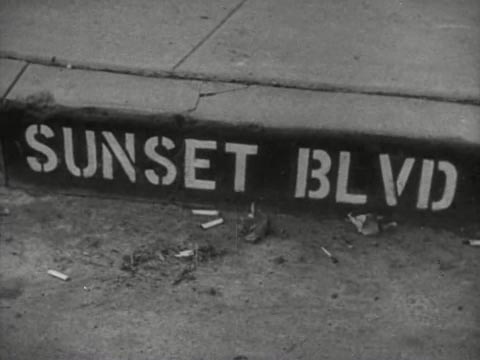Sunset Boulevard (lost alternate opening from noir film; 1950): Difference between revisions
(More polishing.) |
|||
| Line 7: | Line 7: | ||
}} | }} | ||
'''''Sunset Boulevard''''' is a 1950 film noir directed by Billy Wilder. | '''''Sunset Boulevard''''' is a 1950 film noir directed by Billy Wilder. Highly regarded as a classic, and considered Billy Wilder's greatest work, the film co-starred William Holden and silent film actress Gloria Swanson, in what is now her most famous (and Oscar-nominated) role as faded screen goddess Norma Desmond. The film was among the first selected for preservation by the United States Library of Congress (perhaps the highest honor a film can receive). | ||
As it happened, however, the version of Sunset Boulevard that was shown to initial test audiences had an entirely different opening than the theatrical released. The original scene involved hero Joe Gillis (Holden) arriving in a morgue with about a dozen or so other dead bodies. The bodies begin (in voiceover) to trade stories about how they died; Gillis takes his turn and thus the main story of the film unfolds. | |||
While Wilder thought it was one of the best things he ever filmed, when it was shown to test audiences the reaction was uproarious laughter. Understandably upset given the overall bleak, | While Wilder thought it was one of the best things he ever filmed, when it was shown to test audiences the reaction was uproarious laughter. Understandably upset given the overall bleak, cynical tone he was trying to establish, Wilder decided to go back and re-shoot the scene from scratch. It is reported to have cost Paramount Pictures $150,000, but no-one complained when they saw the revisions. The new opening, which preserved the 'story of how I died' concept but now involved only Gillis' dead body alone and floating in a pool, has become iconic. | ||
Along with the original ending to another Wilder film, [[Double Indemnity alternate ending (lost scene; 1944)|''Double Idemnity'']], this is an important bit of lost moviemaking history. Fans were disappointed, when the DVD was issued, to find | Along with the original ending to another Wilder film, [[Double Indemnity alternate ending (lost scene; 1944)|''Double Idemnity'']], this is an important bit of lost moviemaking history. Fans were disappointed, when the DVD was issued, to find the 'bonus feature' of the original opening consisted only of snippets of the original script and the surviving outtake shots. The completed opening was only ever shown to those few test audiences, and little is known about what became of it. Given the general disregard for film preservation at the time, it is highly unlikely that it survived. | ||
[[Category:Lost films]] | [[Category:Lost films]] | ||
Revision as of 02:16, 5 December 2018
Sunset Boulevard is a 1950 film noir directed by Billy Wilder. Highly regarded as a classic, and considered Billy Wilder's greatest work, the film co-starred William Holden and silent film actress Gloria Swanson, in what is now her most famous (and Oscar-nominated) role as faded screen goddess Norma Desmond. The film was among the first selected for preservation by the United States Library of Congress (perhaps the highest honor a film can receive).
As it happened, however, the version of Sunset Boulevard that was shown to initial test audiences had an entirely different opening than the theatrical released. The original scene involved hero Joe Gillis (Holden) arriving in a morgue with about a dozen or so other dead bodies. The bodies begin (in voiceover) to trade stories about how they died; Gillis takes his turn and thus the main story of the film unfolds.
While Wilder thought it was one of the best things he ever filmed, when it was shown to test audiences the reaction was uproarious laughter. Understandably upset given the overall bleak, cynical tone he was trying to establish, Wilder decided to go back and re-shoot the scene from scratch. It is reported to have cost Paramount Pictures $150,000, but no-one complained when they saw the revisions. The new opening, which preserved the 'story of how I died' concept but now involved only Gillis' dead body alone and floating in a pool, has become iconic.
Along with the original ending to another Wilder film, Double Idemnity, this is an important bit of lost moviemaking history. Fans were disappointed, when the DVD was issued, to find the 'bonus feature' of the original opening consisted only of snippets of the original script and the surviving outtake shots. The completed opening was only ever shown to those few test audiences, and little is known about what became of it. Given the general disregard for film preservation at the time, it is highly unlikely that it survived.

